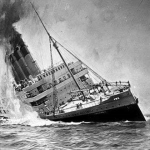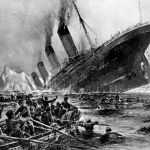australian
 Lieutenant Thomas “Diver” Derrick was one of the 2/48th Battalion of the Australian 9th Infantry division battalion’s most decorated and beloved soldiers, serving in Australia’s most decorated unit in World War II. He was the best of the best, but it was after one event that he actually gained notoriety. Derrick was born on March 20, 1914, at the McBride Maternity Hospital in the Adelaide suburb of Medindie, South Australia, to David Derrick, a laborer from Ireland, and his Australian wife, Ada (née Whitcombe). The Derricks were poor, and Tom often walked barefoot to attend Sturt Street Public School and later Le Fevre Peninsula School. In 1928, aged fourteen, Derrick left school and found work in a bakery. By this time, he had developed a keen interest in sports, particularly cricket, Australian Rules Football, boxing and swimming; his diving in the Port River earned him the nickname of “Diver.”
Lieutenant Thomas “Diver” Derrick was one of the 2/48th Battalion of the Australian 9th Infantry division battalion’s most decorated and beloved soldiers, serving in Australia’s most decorated unit in World War II. He was the best of the best, but it was after one event that he actually gained notoriety. Derrick was born on March 20, 1914, at the McBride Maternity Hospital in the Adelaide suburb of Medindie, South Australia, to David Derrick, a laborer from Ireland, and his Australian wife, Ada (née Whitcombe). The Derricks were poor, and Tom often walked barefoot to attend Sturt Street Public School and later Le Fevre Peninsula School. In 1928, aged fourteen, Derrick left school and found work in a bakery. By this time, he had developed a keen interest in sports, particularly cricket, Australian Rules Football, boxing and swimming; his diving in the Port River earned him the nickname of “Diver.”
Derrick’s notorious accomplishment came during the Battle of Sattelberg in New Guinea in November 1943. His battalion…the 2/48th was participating in the fight. Over a period of two hours, the Australians made several attempts to clamber up the slopes to reach their objective, but each time they were repulsed by intense machine gun fire and grenade attacks. As dusk fell, it appeared impossible to reach the objective or even hold the ground already gained, and the company was ordered the men to retreat. That order brought about an unusual response in Lieutenant Derrick, who was quoted as saying, “Bugger the CO [commanding officer]. Just give me twenty more minutes and we’ll have this place. Tell him I’m pinned down and can’t get out.” With that, then Sergeant Tom Derrick hoisted the Australian Red Ensign at Sattelberg, New Guinea. He moved forward with his platoon, and Derrick attacked a Japanese post 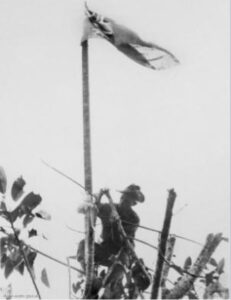 that had been holding up the advance. He quickly destroyed the position with grenades and ordered his second section around to the right flank. The section immediately came under heavy machine gun and grenade fire from six Japanese posts, but that didn’t stop Derrick. Clambering up the cliff face under heavy fire, Derrick held on with one hand while lobbing grenades into the weapon pits with the other. Someone said he was like “a man…shooting for [a] goal at basketball.” Derrick climbed further up the cliff and in full view of the Japanese, he continued to attack the posts with grenades before following up with accurate rifle fire. True to his word, within twenty minutes, he had reached the peak and cleared seven posts…all while the demoralized Japanese defenders fled from their positions to the buildings of Sattelberg. I suppose that if the maneuver had ended differently, Derrick might have been punished for disobeying the order of his commanding officer, but as it was, how could they discipline him for such a one-man-show of prowess.
that had been holding up the advance. He quickly destroyed the position with grenades and ordered his second section around to the right flank. The section immediately came under heavy machine gun and grenade fire from six Japanese posts, but that didn’t stop Derrick. Clambering up the cliff face under heavy fire, Derrick held on with one hand while lobbing grenades into the weapon pits with the other. Someone said he was like “a man…shooting for [a] goal at basketball.” Derrick climbed further up the cliff and in full view of the Japanese, he continued to attack the posts with grenades before following up with accurate rifle fire. True to his word, within twenty minutes, he had reached the peak and cleared seven posts…all while the demoralized Japanese defenders fled from their positions to the buildings of Sattelberg. I suppose that if the maneuver had ended differently, Derrick might have been punished for disobeying the order of his commanding officer, but as it was, how could they discipline him for such a one-man-show of prowess.
Following his successful one-man-attack on the enemy, Derrick returned to his platoon, where he gathered his first and third sections in preparation for an assault on the three remaining machine gun posts in the area. While the platoon was attacking the posts, Derrick personally rushed forward on four separate occasions and threw his grenades at a range of about 8 yards, before all three were silenced. Derrick’s platoon held their position that night, before the 2/48th Battalion moved in to take Sattelberg unopposed the following morning. I’m sure that brought a level of shock to the commanding officer, who had expected a much different outcome and a much different enemy the next morning. The, then proud, battalion commander insisted that Derrick personally hoist the Australian flag over the town. It was raised at 10:00am on November 25, 1943.
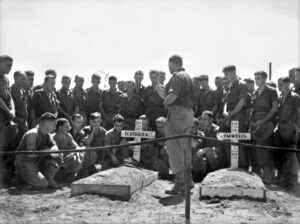 The final assault on Sattelberg was later dubbed “Derrick’s Show” within the 2/48th Battalion. Derrick was already a celebrity within the 9th Division, but this action brought him to wide public attention. I suppose that could have been seen as just Derrick’s irritation over the retreat, but it also could have and was taken as disobeying an order. Derrick had advanced on multiple Japanese machine gun positions, uphill through the jungle, while under covering fire from his squadmates…and he did it by himself. In all, he cleared out 10 enemy positions, helping his unit accomplish their objective and receiving the Victoria Cross for his efforts. Unfortunately, Derrick was killed late in World War II, suffering grievous injuries at the Battle of Tarakan in May 1945.
The final assault on Sattelberg was later dubbed “Derrick’s Show” within the 2/48th Battalion. Derrick was already a celebrity within the 9th Division, but this action brought him to wide public attention. I suppose that could have been seen as just Derrick’s irritation over the retreat, but it also could have and was taken as disobeying an order. Derrick had advanced on multiple Japanese machine gun positions, uphill through the jungle, while under covering fire from his squadmates…and he did it by himself. In all, he cleared out 10 enemy positions, helping his unit accomplish their objective and receiving the Victoria Cross for his efforts. Unfortunately, Derrick was killed late in World War II, suffering grievous injuries at the Battle of Tarakan in May 1945.
 The Gallipoli campaign took place between April 1915 and December 1915 in an effort to take the Dardanelles from the Turkish Ottoman Empire…an ally of Germany and Austria, and thus force it out of the war. About 60,000 Australians and 18,000 New Zealanders were part of a larger British force. Among the wounded were some 26,000 Australians and 7,571 New Zealanders, while 7,594 Australians and 2,431 New Zealanders were killed. Numerically, Gallipoli was a minor campaign, but it took on considerable national and personal importance to the Australians and New Zealanders who fought there.
The Gallipoli campaign took place between April 1915 and December 1915 in an effort to take the Dardanelles from the Turkish Ottoman Empire…an ally of Germany and Austria, and thus force it out of the war. About 60,000 Australians and 18,000 New Zealanders were part of a larger British force. Among the wounded were some 26,000 Australians and 7,571 New Zealanders, while 7,594 Australians and 2,431 New Zealanders were killed. Numerically, Gallipoli was a minor campaign, but it took on considerable national and personal importance to the Australians and New Zealanders who fought there.
The Gallipoli Campaign was Australia’s and New Zealand’s introduction to the Great War. Many Australians and New Zealanders fought on the Peninsula from the day of the landings (April 25, 1915) until the evacuation on December 20, 1915. The 25th April is the New Zealand equivalent of Armistice Day and is marked as the ANZAC day in both countries with Dawn Parades and  other services in every city and town. Shops are closed in the morning. It is a very important day to Australians and New Zealanders for a variety of reasons that have changed and transmuted over the years. This campaign, while small in losses, was huge in the hearts of the Australians and New Zealanders.
other services in every city and town. Shops are closed in the morning. It is a very important day to Australians and New Zealanders for a variety of reasons that have changed and transmuted over the years. This campaign, while small in losses, was huge in the hearts of the Australians and New Zealanders.
While many losses came out of this campaign, it seems that there were two who were saved…potentially anyway. After the campaign was over, and people were wandering the area, someone came across an unusual, and seriously rare, find. There on the ground were two bullets that had collided with each other in mid-air, thus saving the lives of the two combatants who fired the rounds. Obviously, they could have been hit by another round, in which case the mid-air collision only slightly prolonged their lives. At least this scenario might be what you would think. The reality is that you would be wrong. Taking a look closer at the bullets, it is quite obvious that one round collided with 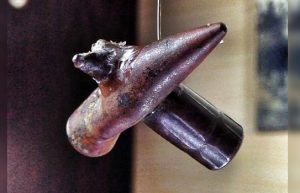 another. But the round on the left doesn’t have any rifling on it, whereas the round on the right does. They collided, but in reality, the round on the left probably wasn’t moving as fast as an actual speeding bullet. Maybe it was part of a clip on an ANZAC soldiers webgear as he was in an attack, or some other bizarre reason. But this most certainly wasn’t the intersection of two trajectories between the lines…making such a collision between two bullets even more rare. Nevertheless, the picture itself is quite interesting, and would have caught the eye of anyone looking at it. How they got there really makes no difference, but the fact that they were found on the Gallipoli battlefield makes them an interesting find. If you ask me, it is still a very rare occurrence.
another. But the round on the left doesn’t have any rifling on it, whereas the round on the right does. They collided, but in reality, the round on the left probably wasn’t moving as fast as an actual speeding bullet. Maybe it was part of a clip on an ANZAC soldiers webgear as he was in an attack, or some other bizarre reason. But this most certainly wasn’t the intersection of two trajectories between the lines…making such a collision between two bullets even more rare. Nevertheless, the picture itself is quite interesting, and would have caught the eye of anyone looking at it. How they got there really makes no difference, but the fact that they were found on the Gallipoli battlefield makes them an interesting find. If you ask me, it is still a very rare occurrence.


